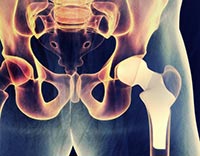
Hip Endoprosthesis Surgery (Hip replacement- THR)
A hip endoprosthesis surgery replaces a joint that no longer functions properly because of an injury or illness with an artificial one. In many cases, a hip replacement is the best treatment to restore function in the hip.

This surgical procedure is widely used on an international scale because of the short recovery time and ability to live actively without hinderance from joint pain. Many patients undergo a hip endoprosthesis surgery to treat a traumatic lesion or an infection in the hip joint, but other common reasons include ankylosing spondylitis, osteoarthritis and rheumatoid arthritis.
Why It’s Performed
Part of the globular joint group, the hip joint is an essential joint of the body’s locomotor system. The hip takes on a significant load and while completing many kinds of movements including outside, inside, abduction, extension and flexion. There is a femoral head in the joint and it connects to the acetabulum, the socket insulated by pelvic bones, through a ligament. With regard to physics, the hip joint is able to function due to the way the head of the femur sits in the acetabulum.
In order for the acetabulum to move smoothly, it is filled with a special adipose tissue, and the femoral head in the cavity moves smoothly because of a special soft cartilage that shields the head. This entire joint structure is stabilized by strong ligaments and cushioned by a fibrous capsule. That capsule is enveloped by a final layer made up of an adipose pad. The lower portion of the joint has a special slot where another ligament and a cluster of blood vessels enter the joint.
Inside a normal functioning hip joint there are several small ligaments to help strengthen the joint. When the hip joint is healthy and working properly, the surfaces of the femoral head and cavity are protected by a special soft cartilage that absorbs shock to the body when a person moves in a vertical position.
Osteoarthritis or coxarthrosis is a common disease of the hip joint that degrades joint cartilage and is accompanied by pain and discomfort. These types of diseases typically are chronic in nature and cause limited function and slow degradation of the hip joint and potentially other joints. In general, people with osteoarthritis experience periods of inflammation that usually causes mild to severe pain in their joints. When the problem is flaring up, patients tend to seek medical attention and complain of pain while walking, sitting or being upright in the knees, thighs or side of the groin.
Most patients with a disease causing impaired hip joints are usually between the ages of 60 and 65. On top of changes to the body related to age that lead to hip joint issues, patients can experience symptoms because of a number of injuries, fractures, circulatory disorders and joint diseases such as arthritis. To determine if a hip endoprosthesis procedure is right for you, your doctor will take a variety of factors into account including your overall health, age, severity of discomfort and structural changes to the joint.
How It’s Performed
Surgeons use one of two approaches to a hip endoprosthesis procedure: one-sided or complete prosthesis. During a one-sided prosthesis, the surgeon replaces only the femoral head. During a complete prosthesis, the surgeon replaces the whole hip joint.
When performing a complete prosthesis, the surgeon operates using one of the three methods of prosthesis fixation:
- Cementless Fixation - The regeneration of bone tissue is stimulated for proper fixation.
- Cement Fixation - The joint elements are secured by special bone cement.
- Combined Fixation - The joint is fixed using the methods of both cementless and cement fixation.
There are currently about 60 different kinds of artificial hips used by modern medicine. Prosthetic hip joints are comprised of strong, safe materials that are compatible with the body. The surfaces of prosthetic hip joints are particularly susceptible to friction as they move in accordance with human movement. As a result, these surfaces are made of specific polymers, ceramics or metal alloys. The other types of surfaces that come into contact with the prosthesis can be ceramics-to-ceramics, metal-to-metal or metal-to-plastic.
Most physicians prefer a pair of metal-to-plastic pieces that offers superior joint function in the long run. Although it is widely used in joint replacement, there is one significant disadvantage to consider, the quick degradation of the plastic. When the patient is active, pieces of plastic break off into the joint tissue, leading to a substantial loosening of the joint. This requires a second hip endoprosthesis procedure. For this reason, a pair of ceramic-to-ceramics may be considered, but they aren’t used much because of the lower strength material and manufacturing challenges. It is more like that the replacement joint will be metal-to-metal because of its strong material and resistance to general wearing. As opposed to the other options, a metal-to-metal artificial hip may remain intact for as long as 20 years.
Expected Results
Statistics show that approximately 95% of hip replacement procedures are successful and the newly implanted hip joint functions as normal. While recovering, patients should avoid heavy lifting, sudden movements and jumping. Generally speaking, patients are able to return to their lifestyle after a few months. Many patients experience full recovery and return to playing active, or even contact, sports.
Artificial hip joints, are prone to wear, but the duration of the prosthesis depends on a number of factors, including:
- quality of artificial hip
- quality of surgeon and hip endoprosthesis procedure
- adherence to rehabilitation guidelines and rules by the patient
- age of patient, young people tend to be more active and wear out a prosthesis more quickly
After about 15-20 years, the prosthesis begins to loosen and the physical mechanisms deconstruct. When this happens, the patient starts to experience pain again and a second procedure is required. Referred to as auditing, the surgeon will remove the old prosthesis and replace it with a new artificial hip.
Leading department specialists


THR - price comparison Israel/US
| Procedure | US Hospitals | Rambam hospital | Average Savings |
| Hip Replacement | $41,000 - $43,000 | $18,000 - $21,000 | 45%-56% |
THR surgery package at Rambam 2018
| Hip Replacement (THR) | Price $ |
|
The Package Includes: * Up to 7 days of hospitalization. * Surgery operating room charges: recovery room, scrub & circulating nurse. * Routine laboratory tests necessary for the procedure as ordered by the attending physician. * Radiology Studies: Chest X-ray, if required. * Medications: Routine medication used for procedure, during admission only. * Equipment costs: Medical Supplies, Routine Surgery Supplies. * Doctor Fees: Orthopedist + Anesthesiologist + Assistant orthopedist (if necessary) |
18,500 - 21,000 |








